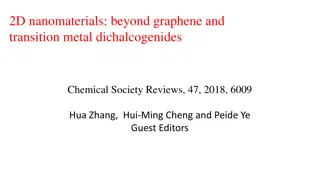Understanding Carbon-Based Nanomaterials and Their Technical Applications
Carbon-based nanomaterials, including fullerenes and carbon nanotubes, have revolutionized various industries with their unique properties. These materials, classified based on their geometrical structure, have applications in fields such as electronics, gas storage, biotechnology, and more. Fullerenes, such as the well-known C60 molecule, exhibit symmetrical structures composed of carbon atoms. Carbon nanotubes, in single-walled or multi-walled forms, offer exceptional properties suitable for diverse technical applications. The versatility and functionality of carbon-based nanomaterials make them essential in advancing modern technology.
Download Presentation

Please find below an Image/Link to download the presentation.
The content on the website is provided AS IS for your information and personal use only. It may not be sold, licensed, or shared on other websites without obtaining consent from the author. Download presentation by click this link. If you encounter any issues during the download, it is possible that the publisher has removed the file from their server.
E N D
Presentation Transcript
Carbon Based Nanomaterials By By Dr. Raouf Mahmood Dr. Raouf Mahmood
Types of Nanomaterials Most current nanomaterials could be organized into four types: Carbon Based Materials Metal Based Materials Dendrimers Composites
Types of Nanomaterials Until recently, only two natural carbon allotropes were known: diamond and graphite. All nanomaterials composed of carbon atoms are termed as carbon-based or carbon nanomaterials. The Classification of carbon-based nanomaterials is most commonly performed according to their geometrical structure. Carbon nanostructures include particles that be tube-shaped, horn-shaped, spherical or ellipsoidal.
Types of Nanomaterials In the meantime, carbon nanomaterials have numerous technical applications including micro- and nanoelectronics, gas storage, production of conductive plastics, composites, displays, antifouling paints, textiles, batteries with improved durability, gas biosensors and others.
Fullerenes Fullerenes are an allotropic modification of carbon, often termed as a molecular form of carbon, or carbon molecules. The fullerene family includes a number of atomic Cn clusters (n > 20), composed of carbon atoms on a spherical surface. Carbon atoms are usually located on the surface of the sphere at the vertices of pentagons and hexagons. In fullerenes, carbon atoms are usually present in the sp2-hybrid form and linked together by covalent bonds. Fullerene C60 is the most common and best-investigated fullerene. The spherical molecule is highly symmetric and consists of 60 carbon atoms, located at the vertices of twenty hexagons and twelve pentagons. The diameter of fullerene C60 is 0.7 nm
Carbon nanotubes (CNTs) CNTs are one of the carbon allotropes with exceptional properties suitable for technical applications. Carbon nanotubes are characterized by cylindrical structures with a diameter of several nanometers, consisting of rolled graphene sheets. Carbon nanotubes may vary in length, diameter, chirality (symmetry of the rolled graphite sheet) and the number of layers. According to their structure, CNTs may be classified into two main groups: single-walled nanotubes (SWCNTs) and multi-walled nanotubes (MWCNTs).
Carbon nanotubes (CNTs) Generally SWCNTs have a diameter around 1 3 nm and a length of a few micrometres. Multi-walled CNTs have a diameter of 5 40 nm and a length around 10 m. The structure of CNTs leads to excellent properties with a unique combination of rigidity, strength and elasticity compared with other fibrous materials. For instance, CNTs show high thermal and electrical conductivity compared to other conductive materials
Carbon nanotubes (CNTs) Electrical properties of SWCNTs depend on their chirality or hexagon orientation with respect to the tube axis. So, SWCNTs are classified into three sub-classes: (i) Armchair (electrical conductivity > copper). (ii) Zigzag (semiconductive properties). (iii) Chiral (semi-conductive properties). By contrast, MWCNTs consisting of multiple carbon layers, frequently with variable chirality, can exhibit extraordinary mechanical properties instead of outstanding electrical characteristics.
Graphene Graphene is a two-dimensional allotropic form of carbon, formed by single layers of carbon atoms . In graphene, carbon atoms exhibit sp2-hybridization connected by - and -bonds in a two-dimensional hexagonal crystal lattice with a distance of 0.142 nm between neighbouring atoms of carbon hexagons. Graphene also represents a structural element of some other carbon allotropes, such as graphite, carbon nanotubes and fullerenes.
Graphene Graphene has many unique physical properties, such as extremely high mechanical rigidity and a high thermal stability. Also the electric properties of this carbon allotrope are fundamentally different from the properties of three-dimensional materials.
References Roston E. The carbon age. How life s core element has become civilization s greatest threat. New York: Walker & Co.; 2009. Peng Q, Dearden AK, Crean J, Han L, Liu S, Wen X, De S. New materials graphyne, graphdiyne, graphone, and graphane: review of properties, synthesis, and application in nanotechnology. Nanotechnol Sci Appl. 2014;7:1 29. De Volder MF, Tawfick SH, Baughman RH, Hart AJ. Carbon nanotubes: present and future commercial applications. Science. 2013;339:535 9.























